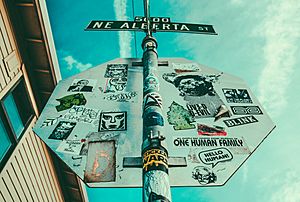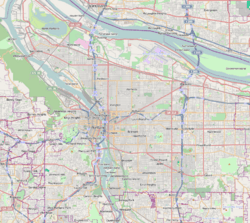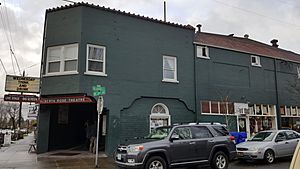Alberta Arts District facts for kids
Quick facts for kids
Alberta Arts District
|
|
|---|---|
|
Commercial district
|
|
 |
|
| Country | United States |
| State | Oregon |
| City | Portland |
The Alberta Arts District is a lively area in Portland, Oregon, connecting the Concordia, King, and Vernon neighborhoods. It's mainly found along NE Alberta Street, stretching about 1.5 miles from Martin Luther King Jr. Boulevard to NE 33rd Avenue.
Once facing tough times, Alberta Street began to change in the early 1990s. Today, it's known as a hub for young people and culture. The street is filled with art galleries, cool restaurants, clothing shops, and gift stores. The neighborhoods around it are popular with both young professionals and people interested in alternative lifestyles.
Contents
History of Alberta Street
Alberta Street got its name from Princess Alberta. It was first settled by immigrants in the 1880s. In 1903, streetcar service started, bringing more people and helping businesses grow. Shop owners often lived in apartments above their stores. Many homes were also built between 1905–1913 and 1922–1928.
Alberta Street had many useful places like grocery stores, barber shops, restaurants, a theater, and a library. There were also several churches for the different groups living there, including German and Russian immigrants.
Changes and Challenges
In the 1950s, many homes south of Alberta Street were removed to build Memorial Coliseum. The people living there, often from minority and lower-income groups, had to move north. In the 1960s, more homes were cleared for Interstate 5. This highway also changed traffic patterns and reduced investment in Alberta Street.
More changes happened in the 1970s when Legacy Emanuel Medical Center expanded. This led to nearly 300 homes and businesses being removed in the nearby Albina neighborhood. Many of these displaced residents moved to the Alberta area. These big projects caused some difficulties for the community.
By 1981, a local landmark, Rexall Pharmacy, closed after 66 years. Banks were hesitant to lend money for homes in the area. The community faced increasing challenges during this time.
Community Revival
To help their neighborhood, people in Alberta formed two groups: the North/Northeast Economic Development Task Force and the Sabin Community Development Corporation. The N/NE Economic Development Task Force dreamed of a better Alberta Street. They created a plan to develop small, local businesses, which the City of Portland approved in 1993. The Sabin CDC helped provide affordable housing.
Many people credit Roslyn Hill, an artist and community leader, for helping turn Alberta Street around. She wanted to keep black-owned businesses on the street. In 1993, she bought an old building and opened a garden cafe. Others who shared her vision soon opened businesses too. Magnus Johannesson bought the old Rexall Pharmacy building. He rented the upstairs to artists and opened a coffee shop downstairs. Roslyn Hill bought and fixed up many more buildings, making sure to rent them to people who cared about the community. From 1996 to 1999, the number of businesses almost doubled.
In 1997, Alberta Street held its first art walk, called Last Thursday. Art galleries opened their doors, and a map showed where to go. At first, not many people came, but the event grew. Soon, street vendors, musicians, and street theater joined in. More independent art galleries opened, and art became a big part of the street's identity. As more people visited, the area slowly became known as an "Art District."
Culture and Events
On the last Thursday of every month, Alberta Street hosts the Last Thursday art walk. In winter, it happens inside galleries and shops. When the weather is warmer, local artists and vendors set up tables along the sidewalks. Street performers and food carts also join the fun.
The Alberta Clown House was once a big part of the lively atmosphere of Last Thursday. It was known for its unique mix of vaudeville, art, and community spirit. Although the Clown House closed in 2007, many of its members still live in the area.
Architecture
The Northwestern Electric Company – Alberta Substation is an important building on Alberta Street. It was built in 1931 and is listed on the National Register of Historic Places, which means it's recognized for its historical importance.
Getting Around
Alberta Street is served by TriMet bus line 72 for part of its length. Other TriMet bus lines (6, 8, 17, and 70) cross Alberta Street at different points.
For cyclists, there are special bike-friendly streets called bicycle boulevards. These run parallel to NE Alberta Street on NE Going Street and NE Skidmore Street.
In Popular Culture
The song "Fat Alberta" by the Portland performance group MarchFourth! is about the changes that have happened on Alberta Street.
Images for kids






